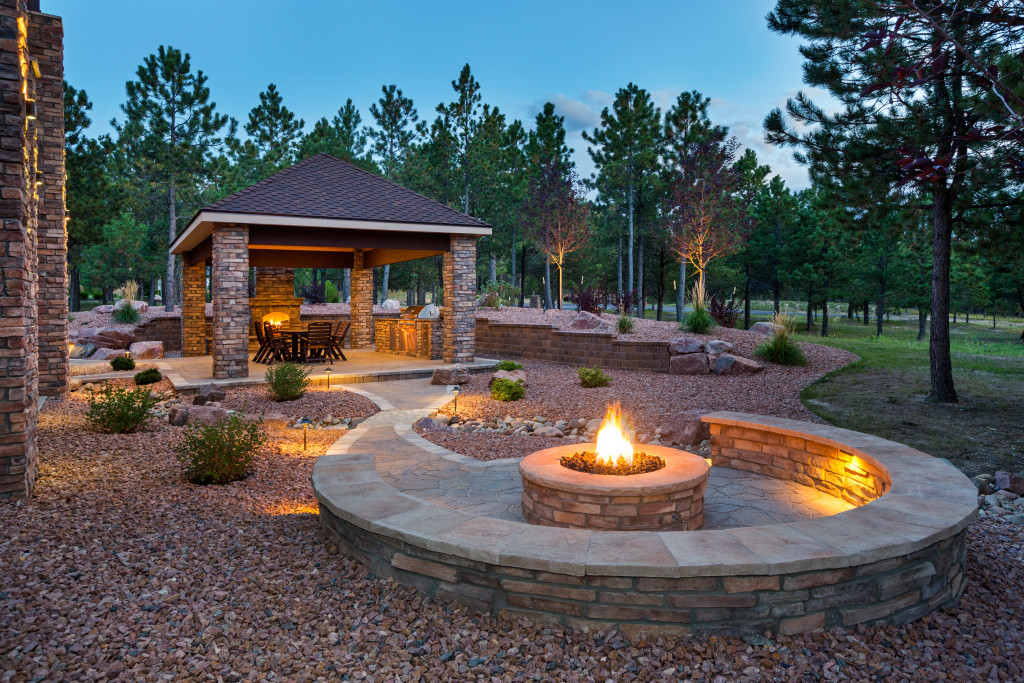When it’s cold outside, you’re only choice is to stay indoors. But when you’ve been cooped up for too long because of the pandemic, you have nothing in your mind but spend time outdoors. A fire pit is a perfect spot to spend time outdoors, even when it’s cold. You can gather with your family and friends in the warmth that it provides. Plus, you can barbecue, roast, or even grill some foods in the fire. Nothing beats good food, quality company, and warmth from a fire on a cold autumn or winter evening.
While a fire pit provides all of this, it can also be a place that has hazards. Considering this, you have to choose the suitable building materials to build one. Remember, its primary function is high-temperature containment.
You need to use fire-resistant materials when building a fire pit. However, because fire-resistant materials can still catch flames, you also need non-flammable and non-combustible materials. According to the National Fire Protection Association, non-combustible materials don’t get deformed, change state, lose strength, melt, burn, and ignite when subjected to fire. Some of the best examples include natural stone, clay bricks, and concrete.
With the right base materials, you can now build your very own DIY in-ground permanent fire pit. Before you start, though, you need to get a permit.
Fire Pit Permit
To ensure that anyone who uses a fire pit is safe and poses no hazards to the environment, you must comply with building codes. They vary at every local and state level. In general, though, you’ll need a permit to build a permanent fire pit and burn in the open air. You’ll also need a certification for setting up its appliance.
A fire pit’s appliance allows it to burn wood. You’ll need a certification to operate one in your backyard. It’s often a requirement for getting a fire pit permit. An open-air burning permit, on the other hand, is acquired separately.
An open-air burning permit is necessary, considering the wind can carry smoke to your neighbors. This is to avoid any complaints from them. This is also one of the reasons why it’s a good idea to get the best fence for winter or autumn. You can minimize smoky drafts blowing towards your neighbor’s windows and, at the same time, provide privacy when you’re enjoying your fire pit.
In addition, according to Family Handyman, you’ll need to inform your utility companies before you do any digging. They’ll tell you where utility lines are located so that you can avoid them.
When you get the necessary certification and permits, you can proceed with building your pit. Here are the materials you need for each of its parts.
Structure
You have two options for your fire pit’s structure. You can build one with an internal wall or one without. If you want one with an inner wall, you can use fire bricks that are put together with fire-proof grout or mortar or use a steel campfire ring. An interior wall or steel frame can make your fire pit sturdier and stronger to resist weather elements.
On the other hand, you can build your fire pit straight away without internal walls. You can use pavers, stones, poured concrete, or masonry blocks for the rest of its structure.

Caps
Most in-ground fire pits are capped to make their topmost layer flat. Capping also provides a finished rim. If you want to add a cap to your fire pit, you can use bricks, flagstone, precast concrete, veneers, or ceramic tiles.
Fill Material
Fillers are used mainly for decorative purposes to cover fire rings if you opt for a gas-powered fire pit. However, they can also help absorb heat, radiating warmth more evenly. You can use recycled glass, river rocks, and lava rock are fill materials.
Drainage
Drainage is vital to prevent rainwater and melted snow from accumulating at the bottom of a fire pit. Common drainage materials are lava rocks, fire glass, pebble stones, sand, and gravel.
Ventilation
A fire pit should have three vents. It is required to allow combustion in wood fire pits and reduce fire pressure buildup in gas-powered pits. Materials used for the fire pit’s structure are also suitable for building vents.
Fire Pit Floor
Finally, for the fire pit bottom, you can use lava rocks, sand, or gravel. This is whether you’re installing a wood or gas fire pit.
When you’ve finished your fire pit, allow mortar or cement to cure for a week. Don’t light a fire in it until a week is done.
More Than Just Warmth
A fire pit provides not just warmth. It’s also a cooking and light source that can significantly add to the cozy ambiance you’re aiming for. Just don’t forget to use only the right materials when you’re about to build one.

